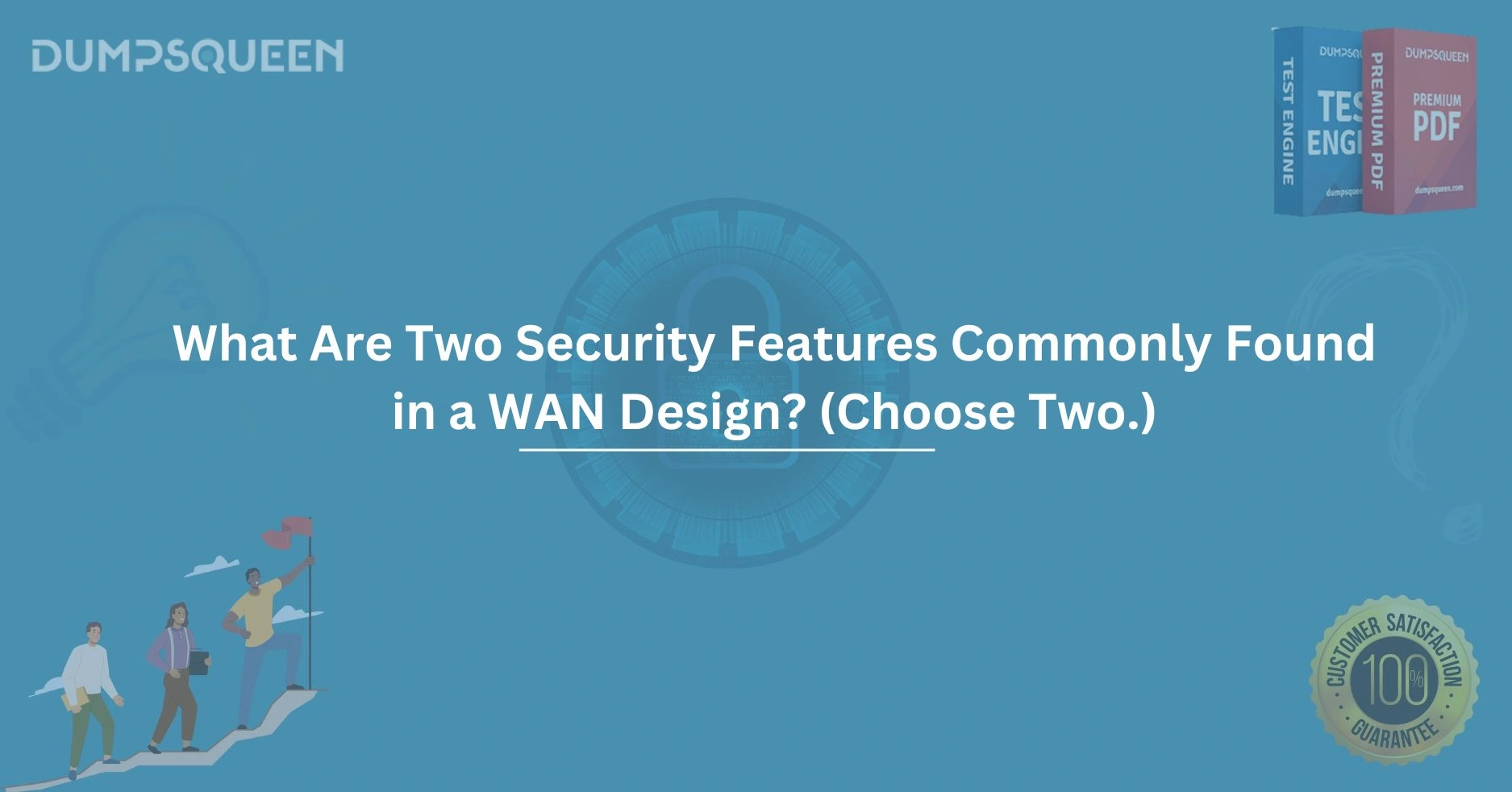Introduction
Wide Area Networks (WANs) are the backbone of modern enterprise connectivity, enabling organizations to link geographically dispersed locations, share resources, and maintain seamless communication. As businesses increasingly rely on WANs to support critical operations, securing these networks has become paramount. Cyberthreats such as data breaches, unauthorized access, and malware pose significant risks to WAN integrity, making robust security measures essential. Among the myriad security features available, two stand out as commonly implemented in WAN designs: firewalls and Virtual Private Networks (VPNs). This blog, brought to you by DumpsQueen, delves into these two critical security features, exploring their roles, mechanisms, and importance in safeguarding WAN environments. Whether you’re preparing for a certification exam or seeking to enhance your network security knowledge, DumpsQueen is your trusted partner in achieving success.
The Role of Firewalls in WAN Security
A firewall is a fundamental security component in any WAN design, acting as a gatekeeper between trusted internal networks and untrusted external environments. Its primary function is to monitor and control incoming and outgoing network traffic based on predefined security rules. In a WAN, where data traverses vast distances and potentially insecure public networks, firewalls provide a critical layer of defense against unauthorized access and malicious activities.
Firewalls operate by inspecting packets of data, evaluating their source, destination, and content against a set of rules. These rules can be configured to allow or block traffic based on criteria such as IP addresses, port numbers, or specific protocols. For example, a firewall might permit HTTP traffic to a web server while blocking unsolicited inbound connections to sensitive internal systems. In a WAN context, firewalls are typically deployed at network boundaries, such as the point where an organization’s private network connects to an Internet Service Provider (ISP) or a partner network.
Beyond basic packet filtering, modern firewalls offer advanced capabilities like stateful inspection, which tracks the state of active connections to ensure only legitimate traffic is allowed. For instance, a stateful firewall can recognize that an outgoing request for a webpage should be followed by an incoming response from the same server, allowing the response while blocking unrelated inbound packets. Some firewalls also include deep packet inspection (DPI), which examines the content of packets for signs of malware or other threats.
In WAN designs, firewalls are often implemented in a distributed manner. For example, a large enterprise with multiple branch offices might deploy firewalls at each site to protect local networks while maintaining centralized control through a unified management system. This approach ensures consistent security policies across the WAN, reducing the risk of vulnerabilities at remote locations. Additionally, firewalls can be integrated with intrusion detection and prevention systems (IDPS) to enhance threat detection and response capabilities.
By filtering traffic and enforcing security policies, firewalls help prevent common threats such as Distributed Denial of Service (DDoS) attacks, unauthorized access attempts, and data exfiltration. For organizations relying on WANs to connect offices, partners, or cloud services, firewalls are indispensable for maintaining confidentiality, integrity, and availability. At DumpsQueen, we emphasize the importance of understanding firewall functionality for certifications like Cisco CCNA and CompTIA Network+, as mastery of this topic is crucial for network professionals.
Virtual Private Networks (VPNs): Securing Data in Transit
The second cornerstone of WAN security is the Virtual Private Network (VPN), a technology that ensures secure communication over potentially insecure networks, such as the public internet. In a WAN, where data often travels across untrusted infrastructure, VPNs create encrypted tunnels between endpoints, safeguarding sensitive information from interception and tampering.
A VPN works by encapsulating data packets within a secure protocol, encrypting the contents to render them unreadable to unauthorized parties. Common VPN protocols include IPsec (Internet Protocol Security), SSL/TLS (Secure Sockets Layer/Transport Layer Security), and PPTP (Point-to-Point Tunneling Protocol), with IPsec and SSL/TLS being the most widely used in modern WAN designs. IPsec, for instance, operates at the network layer, securing all traffic between two endpoints, while SSL/TLS is often used for application-specific VPNs, such as secure remote access to a corporate intranet.
In a typical WAN scenario, a VPN might connect a branch office to the headquarters network. Employees at the branch office can access internal resources, such as file servers or databases, as if they were on the local network, with all data transmitted securely through the VPN tunnel. Similarly, remote workers can use VPNs to connect to the corporate WAN from home or while traveling, ensuring their communications remain private even on public Wi-Fi networks.
VPNs offer several security benefits beyond encryption. Authentication mechanisms, such as digital certificates or multi-factor authentication (MFA), verify the identity of users and devices before granting access to the VPN. This prevents unauthorized entities from infiltrating the network. Additionally, VPNs can enforce access control policies, restricting users to specific resources based on their roles. For example, a sales team member might access customer relationship management (CRM) software via the VPN but be denied access to financial systems.
In WAN designs, VPNs are particularly valuable for site-to-site connectivity and remote access. Site-to-site VPNs link multiple office locations, creating a unified network environment while maintaining security. Remote access VPNs, on the other hand, enable individual users to connect securely from anywhere, supporting the growing trend of hybrid and remote work. Both configurations rely on robust encryption and authentication to protect data in transit, making VPNs a versatile and essential feature of WAN security.
At DumpsQueen, we recognize that VPNs are a key topic in certifications like Cisco CCNP and CompTIA Security+. Understanding how VPNs secure WAN communications is vital for network engineers tasked with designing and maintaining secure infrastructures. Our resources at DumpsQueen provide in-depth study materials to help you master VPN concepts and excel in your exams.
Complementary Nature of Firewalls and VPNs in WANs
While firewalls and VPNs serve distinct purposes, they complement each other to create a robust security posture in WAN designs. Firewalls focus on controlling access and filtering traffic at network boundaries, acting as the first line of defense against external threats. VPNs, meanwhile, ensure the confidentiality and integrity of data as it travels across the WAN, protecting it from eavesdropping and manipulation.
Consider a multinational corporation with offices in New York, London, and Tokyo. Firewalls at each location enforce security policies, blocking unauthorized traffic and monitoring for suspicious activity. Site-to-site VPNs connect the offices, encrypting data as it flows between locations. Together, these features ensure that only legitimate traffic enters the network and that sensitive information remains secure during transmission.
This synergy is particularly important in today’s threat landscape, where cyberattacks are becoming more sophisticated. For example, a firewall might detect and block a phishing attempt originating from an external source, while a VPN ensures that an employee accessing the network remotely does so securely, even if their connection is compromised. By combining access control with encryption, firewalls and VPNs address multiple attack vectors, enhancing overall WAN security.
DumpsQueen study guides emphasize the interplay between firewalls and VPNs, offering practical insights for certification candidates. Whether you’re studying for Cisco, CompTIA, or other IT exams, our resources at DumpsQueen help you understand how these technologies work together to protect enterprise networks.
Challenges and Considerations in Implementing Firewalls and VPNs
Implementing firewalls and VPNs in a WAN design is not without challenges. Firewalls require careful configuration to balance security and performance. Overly restrictive rules can block legitimate traffic, disrupting business operations, while overly permissive rules may leave vulnerabilities exposed. Regular updates and monitoring are necessary to adapt to evolving threats, such as new malware variants or zero-day exploits.
VPNs, meanwhile, can introduce latency due to the overhead of encryption and tunneling. In high-bandwidth WANs, this can impact application performance, particularly for real-time services like video conferencing. Organizations must select appropriate VPN protocols and hardware to minimize latency while maintaining security. Scalability is another consideration, as VPNs must support growing numbers of users and devices without compromising performance.
Both technologies also require skilled personnel to manage and maintain them. Misconfigurations, such as weak encryption settings in a VPN or outdated firewall rules, can undermine security. Ongoing training and certification preparation, supported by platforms like DumpsQueen, are essential for IT professionals tasked with securing WANs.
Despite these challenges, the benefits of firewalls and VPNs far outweigh the drawbacks. With proper planning and management, they provide a strong foundation for WAN security, enabling organizations to operate confidently in a connected world. DumpsQueen comprehensive resources empower professionals to overcome these challenges and build secure, efficient networks.
Conclusion
Securing a Wide Area Network is a complex but critical task in today’s interconnected world. Firewalls and Virtual Private Networks stand out as two of the most commonly implemented security features in WAN designs, each playing a vital role in protecting enterprise networks. Firewalls act as vigilant gatekeepers, controlling access and filtering threats, while VPNs ensure data remains confidential and intact during transmission. Together, they form a powerful defense against the myriad risks facing modern WANs, from cyberattacks to data breaches.
At DumpsQueen, we are committed to helping IT professionals deepen their understanding of these technologies and excel in their careers. Whether you’re studying for a certification or seeking to enhance your network security expertise, our resources provide the knowledge and confidence you need to succeed. By mastering firewalls, VPNs, and other WAN security features, you can contribute to building resilient, secure networks that empower organizations to thrive.
Free Sample Questions
Question 1: Which security feature in a WAN design is primarily responsible for controlling network traffic based on predefined rules?
A) Virtual Private Network (VPN)
B) Firewall
C) Intrusion Detection System (IDS)
D) Encryption Protocol
Answer: B) Firewall
A) Filtering malicious packets
B) Encrypting data in transit
C) Monitoring network performance
D) Managing IP address allocation
Answer: B) Encrypting data in transit
A) HTTP
B) IPsec
C) FTP
D) SNMP
Answer: B) IPsec
A) Firewalls encrypt data, while VPNs filter traffic
B) Firewalls control access, while VPNs secure data in transit
C) Both perform identical security functions
D) VPNs replace the need for firewalls
Answer: B) Firewalls control access, while VPNs secure data in transit



